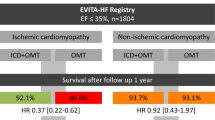Summary
Background
Implantable cardioverter defibrillators represent an effective therapy to prevent sudden cardiac death in patients with ventricular arrhythmias. This implies a change in the spectrum of causes of death. There exist no large studies providing an exact differentiation of these causes of death.
Methods
During a mean observation period of 41±29 months (3 d–12 yrs), we analyzed the outcome of 429 ICD patients (CAD n=274, dilative CMP n=97, others n=23, no structural heart disease n=35), mean age 62±12 years (23–87 yrs).
Results
The overall survival rate was 79.7% whereby 3.5% of these patients underwent successful heart transplantation and 2.1% died suddenly. 60.9% of all deaths showed a non-sudden cardiac cause (heart failure 56.3%, myocardial infarction 4.6%). In 28.7% a non-cardiac fatal event was present (cancer 11.5%, septicemia 6.9%, stroke 4.6%). The deceased showed significantly more often structural heart disease (100 vs 92%, p<0.02) and a lower left ventricular ejection fraction (37±14 vs 44±18%, p<0.02). Significant higher survival rates were associated with medication with beta blockers (88 vs 75%, p<0.02) and the class III antiarrhythmic agents sotalol und amiodarone (85 vs 77%, p<0.03).
Conclusions
Mortality due to sudden death was reduced to 2.1% in ICD patients associated with a shift of causes of death towards severe heart failure. Therefore, special attention should be paid to the signs of heart failure in these patients to enable early initiation of appropriate therapeutic strategies.
Zusammenfassung
Hintergrund
Der implantierbare Cardioverter/Defibrillator hat sich als effektive Therapie bei Patienten mit lebensbedrohlichen ventrikulären Tachyarrhythmien etabliert. Durch Verhinderung des plötzlichen Herztods kommt es zwangsläufig zu einer Umverteilung im Spektrum der Todesursachen dieser Patienten. Bislang existiert jedoch keine Studie an einem großen Patientenkollektiv, die eine genaue Differenzierung dieser Todesursachen ermöglicht.
Methodik
Wir analysierten über einen mittleren Beobachtungszeitraum von 41±29 Monaten (3 Tage–12 Jahre) den Verlauf von 429 konsekutiven ICD-Patienten (KHK n=274, dilatative CMP n=97, sonstige n=23, keine kardiale Grunderkrankung n=35), mittleres Alter 62±12 Jahre (23–87 Jahre).
Ergebnisse
Die Gesamtüberlebensrate lag bei 79,7%, davon konnten 3,5% einer Herztransplantation zugeführt werden. Insgesamt verstarben 2,1% der Patienten plötzlich. 60,9% aller Verstorbenen erlagen einer nicht-plötzlichen, kardialen Ursache (terminale Herzinsuffizienz 56,3%, Myokardinfarkt 4,6%). In 28,7% führte ein nicht-kardiales Ereignis zum Tode (Malignome 11,5%, Sepsis 6,9%, Apoplex 4,6%). Verstorbene Patienten wiesen signifikant häufiger eine strukturelle Herzerkrankung (100 vs 92%, p<0,02) und eine niedrigere LVEF (37±14 vs 44±18%, p<0,02) auf. Weiterhin zeigten sich signifikant höhere Überlebensraten sowohl unter β-Blocker-Medikation (88 vs 75%, p<0,02) als auch bei Gabe der Klasse-III-Antiarrhythmika Sotalol und Amiodaron (85 vs 77%, p<0,03).
Schlussfolgerungen
Die Analyse des Langzeitverlaufs von ICD-Patienten zeigt, dass durch die Verhinderung eines rhythmogenen Versterbens die progrediente Herzinsuffizienz die Haupttodesursache dieses Patientenkollektivs darstellt. Deshalb sollte früh auf Anzeichen einer Herzinsuffizienz geachtet werden, um entsprechende optimierte therapeutische Maßnahmen einleiten zu können.
Similar content being viewed by others
References
ACC/AHA Guidelines for the Evaluation and Management of Chronic Heart Failure in the Adult (2002) Executive summary. J Heart Lung Transplant 21:189–203
ACC/AHA TASK FORCE REPORT (1995) Guidelines for the evaluation and management of heart failure. JACC 26:1376–1398
Gradaus R, Block M, Brachmann J, Breithardt G, Huber HG, Jung W, Kranig W, Mletzko RU, Schoels W, Seidl K, Senges J, Siebels J, Steinbeck G, Stellbrink C, Andresen D, on behalf of the German EURID Registry (2003) Mortality, morbidity, and complications in 3344 patients with implantable cardioverter defibrillators: results from the German ICD registry EURID. PACE 26:1511–1518
Hennersdorf MG, Niebch V, Vester EG, Winter J, Perings C, Strauer BE (2003) Long-term follow-up of sudden cardiac arrest survivors and electrophysiologically guided antiarrhythmic therapy. Cardiology 99:190–197
Hoffmann E, Steinbeck G (1998) Experience with pectoral versus abdominal implantation of a small defibrillator. A multicenter comparison in 778 patients. European Jewel Investigators. Eur Heart J 19:1085–1098
Lee DS, Green LD, Liu PP, Dorian P, Newman DM, Grant FC, Tu JV, Alter DA (2003) Effectiveness of implantable defibrillators for preventing arrhythmic events and death. A meta-analysis. J Am Coll Cardiol 41:1573–1582
Kober L, Torp-Pedersen C, Elming H, Burchardt H, on behalf of the TRACE Study Group (1997) Use of left ventricular ejection fraction or wall-motion score index in predicting arrhythmic death in patients following an acute myocardial infarction. PACE 20:2553–2559
Meine M, Müller C, Weismüller P, Trappe HJ (2003) Überlebensrate nach ICD-Implantation: Welche Faktoren beeinflussen die Prognose? Z Kardiol 92:I/206
Author information
Authors and Affiliations
Corresponding author
Rights and permissions
About this article
Cite this article
Fiek, M., Zieg, B., Matis, T. et al. Analyse der Todesursachen von ICD-Patienten in der Langzeitbeobachtung. Herzschr. Elektrophys. 17, 6–12 (2006). https://doi.org/10.1007/s00399-006-0501-5
Received:
Accepted:
Issue Date:
DOI: https://doi.org/10.1007/s00399-006-0501-5




